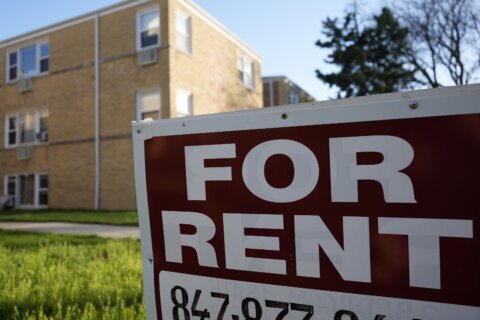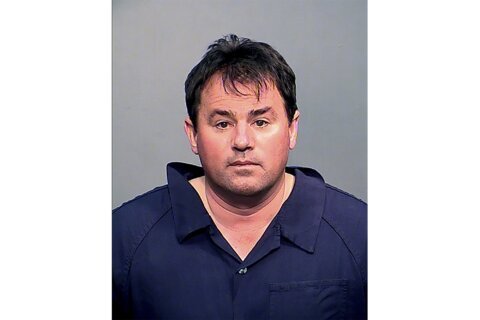FREDERICKSBURG, Va. (AP) — More than 100 times in the last four years, the lives of people like George and Brenda Ford have been changed by an act of kindness — along with the skillful placement of a truckload of boards.
Local volunteers with an organization called SAWs-Virginia heard that George Ford, 87, was unable to get out of his home after he had a stroke in September 2021. His wife had to arrange with two family members to help carry him and his wheelchair out of the house when he needed to go to physical therapy or doctors’ appointments, but she “felt very bad” knowing it disrupted their schedules.
Then, SAWs, which stands for “Servants at Work,” built an 83-foot ramp that starts outside the front door of their Spotsylvania County home, takes a sharp left and runs down a graded slope in front of the porch, then turns left again and ends in the paved driveway.
Suddenly, the couple had their freedom again.
“Having this ramp is a lifesaver,” said Brenda Ford. “We don’t have to depend on anybody and mess up their schedule. This has made us very independent, so thank you so much.”
Even though his speech is somewhat slurred after the stroke, George Ford smiled at the wooden platform around him and thanked everybody for building “this beautiful ramp.”
Men and women in neon green shirts, as well as others in business–casual attire, gathered in the Ford’s front yard to celebrate the 100th wheelchair ramp built since the local SAWs chapter began in May 2019.
The volunteers actually hit the 100-mark in January, but Charlie Russell, executive director, didn’t think that was the best time for an outdoor celebration.
His group invited many of those who have supported the effort, with donations, prayers and sweat equity, to share the fruits of their labor — and some of the 100 cupcakes provided by the Blue Star Mothers of Fredericksburg — as part of the celebration.
The Fords watched the activities from their shaded perch on the porch. Neither expected a ramp as “humongous” as this one, she said. But SAWs sent engineers over twice, part of various teams who help design the ramps or put 8-foot sections together off-site, then assemble them during a six-hour or so effort on the property.
The Ford ramp had to be that long because of the slope and design of the front yard. Workers had to thread the needle, Russell said, building it between an existing flagpole on one side and lantern on the other.
“This one was particularly problematic,” said Ben Raterman, a retired engineer from the Dahlgren Navy base who worked on the design.
But the team figured it out, as they’ve done more than 100 times for veterans, elderly residents, the disabled or those in financial need in Fredericksburg and the counties of Caroline, King George, Spotsylvania and Stafford.
Russell came to Rev. Joseph Hensley Jr. of St. George’s Episcopal Church in 2018, a few months after moving to the area, and told him there was a need for such a ministry locally. Russell had worked with the national SAWs organization in Indiana and said he couldn’t be the one to run the Fredericksburg-based group.
“We see how that worked,” Russell said.
He’s hoping to step down this year, saying that the organization has outgrown him, and speakers praised his efforts. Jim and Vicki Lewis, members of the Fredericksburg Rotary Club, encouraged their organization to support SAWs, and Jim Lewis initially served on the board of directors.
“From there on, it’s grown unbelievably,” he said. “I can’t say enough for Charlie, he’s thrown his heart into this and sacrificed a lot of time. I wish him well finding a replacement because replacing him’s gonna be pretty hard.”
SAWs also has gotten support from The Community Foundation of the Rappahannock River Region, where Casey Hu, donor services manager, is constantly looking for grants to help pay for ramps and materials, Russell said.
Mary Washington Hospital Foundation, led by Xavier Richardson, also has donated funds, given that one of its top community priorities is making sure people have access to health care, said Richardson.
“There are many people in our community who are not fortunate enough to have persons who can transport them, or sometimes they may be limited by their inability to get out of their own homes,” Richardson said. “These ramps increase their accessibility.”
SAWs also has worked with Margaret Kenerly, a social worker with Mary Washington Home Health. She’s referred clients to Russell who were like the Fords, basically trapped in their homes after an injury or illness.
“Ramps are such a simple fix but they can be expensive and cost-prohibitive,” she said. Turning to the green shirts in the audience, Kenerly said a ramp does more than let a homeowner get out of the house again.
“It’s improving our patients’ medical, physical and mental health,” she said. “Thank you to all the volunteers that build that lifeline. Your clients that I meet in the home really appreciate it.”
One of the best parts about the SAWs ramps is that they’re built to be movable, said Sandy Wiseman, one of several project managers for the group. Already, the organization has removed some of the first ramps built, because they were no longer needed for various reasons, and reinstalled them elsewhere, Raterman said.
Hensley saw parallels between that and SAWs itself.
“SAWs is about giving people access, the freedom to move in and out of their homes and responding to the need at the time,” he said.
Copyright © 2024 The Associated Press. All rights reserved. This material may not be published, broadcast, written or redistributed.







